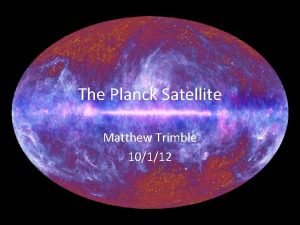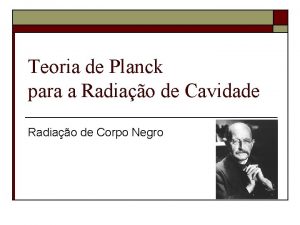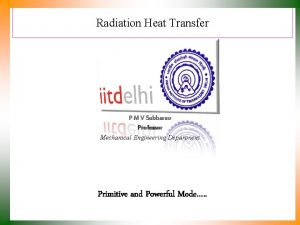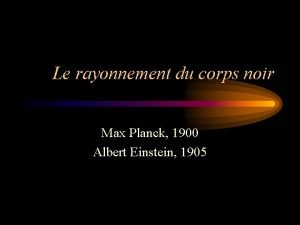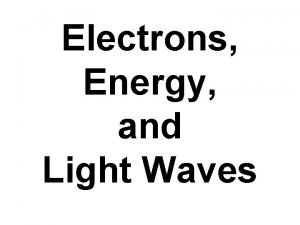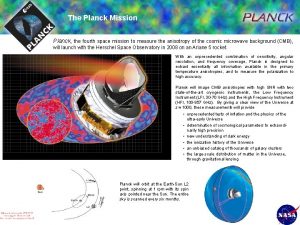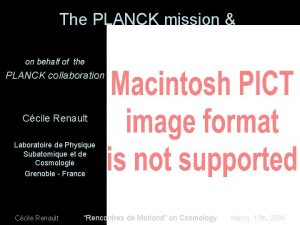US Planck Data Analysis Review Planck Data Analysis







- Slides: 7

US Planck Data Analysis Review Planck - Data Analysis Challenges Krzysztof M. Górski JPL Caltech K. M. Górski US Planck Data Analysis Review • 9– 10 May 2006

Planck - Principal Features Full Sky (if precessing scanning is employed) Measurements of Both Temperature and Polarization over Wide Frequency Range (30 -850 GHz) – (+) Great Potential for Foreground Separation – (--) Complex Cooling System, and Two Detector Types (radiometers and bolometers) Enlarge the Pool of Systematic Effects to Control High Angular Resolution (~ 30– 5 arcmin at 30–≥ 217 GHz) – (+) Wider l-range to explore with less beam attenuation “More Science” – (--) Large and Complicated Focal Plane (different beams even at the same frequency, asymmetric beams, difficult in-flight beam measurements, insufficient beam measurements before launch, etc. ) High Sensitivity – (+) (S/N)T ~ 1 at l~2000 (almost, mode-by-mode characterization) – (--) BUT Correlated Noise in Total Power Receivers Difficulties in Making Sky Maps – (+/-) Enhanced Visibility of Systematic Effects in the Data All of the above drive a significant increase of data volume compared to previous efforts, e. g. WMAP – 100 GB of raw data in 3 years of survey Planck – 3000 GB of raw data in one year survey (after expansion of compressed data transmitted from the spacecraft on the ground; ~10% - LFI, ~90% - HFI data) K. M. Górski 2 US Planck Data Analysis Review • 9– 10 May 2006

Planck Data Analysis - Principal Challenges Algorithmic/Computational Infrastructural Workforce Related K. M. Górski 3 US Planck Data Analysis Review • 9– 10 May 2006

Planck Data Analysis Infrastructure Challenge Data Storage, Security, Access, Transfer, etc. – TBD see presentations by J. Borrill, W. Reach Computing Resources – US Team Perspective: Ø Established access to supercomputing resources (>~103 CPUs) Ø Comfortable access to third party intermediate level computing resources (~10– 100 CPUs, both at JPL and elsewhere) Ø Forthcoming acquisition of similar level resource for the US Planck Team K. M. Górski 4 US Planck Data Analysis Review • 9– 10 May 2006

Planck Data Analysis Work Force Challenge Issues – Training in anticipation of post-launch tasks – Management – Collaboration Control – Efficient Information Exchange K. M. Górski 5 US Planck Data Analysis Review • 9– 10 May 2006

Planck Data Analysis Algorithmic/Computational Challenges US Planck Team’s perspective on the following topics: Data Preprocessing (crudely: TOD analysis, calibration, data preparation for input to map making, etc. ) – Excellent prospects given both HFI, LFI, and the Cooler instrumental expertise coupled with availability of personnel for TOD inspection, systematic assessment, and processing – Complex task(s); GREAT need to utilize the emerging mechanisms of Core Teams to enhance direct working links with DPCs Map Making – Splendid progress – Broad investigation of multiple map making tools – Excellent control of the computational aspects of the problem – Delivery of Unified Map Making Code to both HFI/LFI DPCs, related issues – Capability to generate very realistic simulated Planck data and maps fully at hand – Outstanding problem: Characterization of noise covariance resulting from application of destriping map making codes Component Separation – Very serious challenge, especially for polarization – Beginning of serious involvement (Eriksen et al. 2006, Dickinson hire) K. M. Górski 6 US Planck Data Analysis Review • 9– 10 May 2006

Planck Data Analysis Algorithmic/Computational Challenges Continued: Point Source Identification, Extraction, and Astrophysics Power Spectrum Estimation – Beginning of systematic census and evaluation of existing tools – Open attitude to adoption of not-own software – In the process of evaluation of Xfaster and Pol. Spice – In the process of pushing ahead with Gibbs approach to establish its practicability viz. the Planck data applications Cosmological Parameter Estimation – Need to assess existing param. estim. codes viz. Planck applications on T, Q, U data K. M. Górski 7 US Planck Data Analysis Review • 9– 10 May 2006
